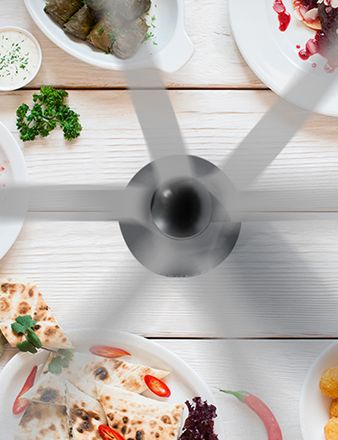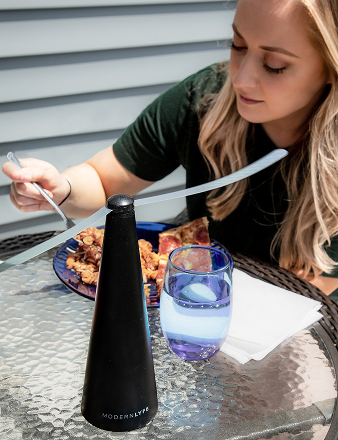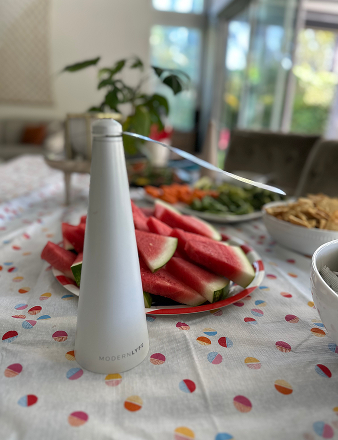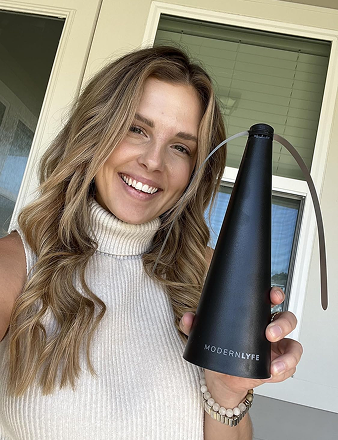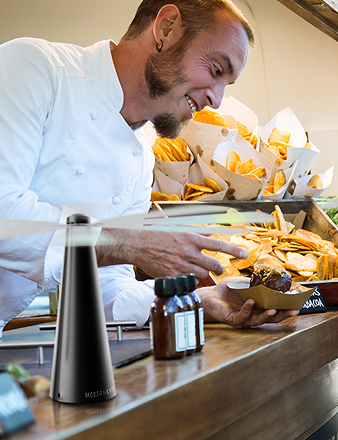Fruit flies show up for a reason. They're drawn to specific things in your home: overripe fruit, a damp sink sponge, or the gunk in your kitchen drain. The first step to getting rid of them is to eliminate these attractants.
It’s a bigger problem than you think. A single female fruit fly can lay hundreds of eggs, turning a minor annoyance into a full-blown infestation in just a few days.
Understanding the Fruit Fly Invasion
One day your kitchen is clear, the next it’s swarming with tiny pests. They don't appear from nowhere—you likely brought them in. Microscopic fruit fly eggs often hitch a ride into your home on the produce you buy.
Their rapid life cycle is what makes them so persistent. A female lays up to 50 eggs a day, which can mature into adults in about a week. You're not just fighting the flies you see; you're battling hundreds of eggs and larvae in hidden breeding spots.
Beyond the Fruit Bowl: Where Flies Thrive
Fruit flies aren't picky. They thrive on any fermenting organic material, which means their hangouts can be in surprising places.
- Your Kitchen Sink: Tiny food particles in the drain or garbage disposal create a perfect, damp buffet.
- Sponges and Dishrags: A sour-smelling sponge is a five-star resort for laying eggs.
- The Recycling Bin: Leftover soda or wine residue in a can or bottle is more than enough to attract them.
- Hidden Spills: A splash of juice under the fridge or crumbs behind the toaster can support a thriving population.
The key to getting rid of fruit flies for good isn't just trapping the adults. You have to find and eliminate their breeding grounds to break the cycle.
Here's a quick guide to common fruit fly hotspots, so you can shut them down before an infestation starts.
Fruit Fly Attraction Hotspots You Might Be Missing
| Location | Hidden Attractant | Quick Fix |
|---|---|---|
| Garbage Disposal | Trapped food particles and grime | Run ice cubes and citrus peels through the disposal. |
| Mop Buckets & Sponges | Stagnant, sour water | Wring out mops/sponges completely and let them dry. |
| Underneath Appliances | Spilled liquids and old crumbs | Pull out appliances and deep clean the floor beneath them. |
| Recycling Bins | Sugary residue in cans and bottles | Rinse all recyclables thoroughly before tossing them in the bin. |
| Houseplant Soil | Overwatering leading to fungus/decay | Let the top layer of soil dry out between waterings. |
Controlling these hotspots is a huge step toward a fly-free kitchen.
This isn't a minor annoyance. The 2023-2024 season saw the worst fruit fly outbreak in 70 years, forcing the USDA to dedicate millions toward control. This shows how crucial proactive measures are. For more details, learn how to control fruit flies in our comprehensive guide.
Building a Fruit Fly-Proof Home
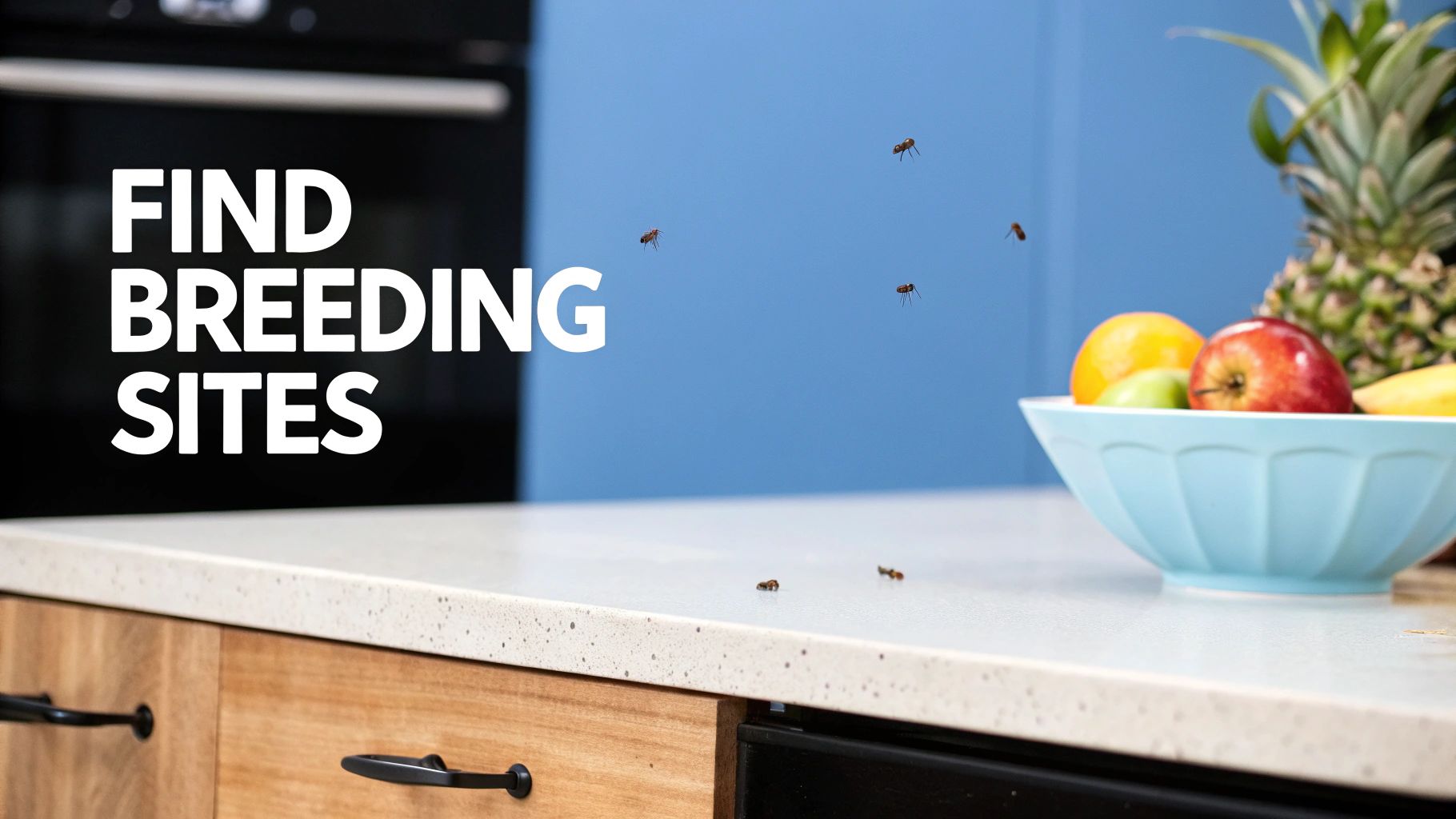
The best defense is making your home an unwelcome place for fruit flies from the start. This isn’t about one frantic cleaning spree; it’s about consistent habits that deny them what they need to survive.
Remember, fruit fly eggs are often invisible passengers on your fresh produce. Your first line of defense begins the moment you bring your groceries home.
Managing Produce from Store to Counter
Leaving fresh peaches or tomatoes on the counter is like setting out a buffet and nursery for fruit flies. You need a "clean and contain" routine.
Start by gently washing all new produce under cool running water. This simple step can rinse away eggs or larvae. For anything you won't eat in a day or two, refrigerate it. The cold temperatures stop the fruit fly life cycle cold.
The takeaway: prevention isn't about creating a sterile environment. It's about being strategic. By managing their food and moisture sources, you remove the two things fruit flies need.
Deep Cleaning Breeding Hotspots
While the fruit bowl is an obvious magnet, hidden breeding grounds keep an infestation going. Your kitchen drains and garbage disposal are prime real estate for fruit flies.
A weekly deep clean of these spots is non-negotiable. Pour boiling water down the drain, or use a combination of baking soda and vinegar. Let the reaction work for about 10 minutes to break down gunk, then flush with hot water.
Don't overlook your waste containers. Here are some critical maintenance tips:
- Compost Bins: Use an indoor pail with a tight-fitting lid. Empty it daily, especially in warm weather, to prevent fermentation.
- Recycling Bins: Always rinse cans, jars, and bottles. A tiny bit of residue is enough for fruit flies to start a family.
- Trash Cans: Wipe down the inside of your trash can regularly. Spills and sticky spots are breeding grounds. A clean bin is a major deterrent.
Leaving dirty dishes or half-empty glasses out overnight is like rolling out the welcome mat. Clean up immediately to close that window of opportunity. This proactive mindset is what makes a home truly fruit-fly-proof.
Creating DIY Traps That Actually Work
When you see fruit flies, you've moved past prevention and into active control. The goal is to trap the adults and break their life cycle. The good news is you can make a powerful trap with items already in your kitchen.
The classic apple cider vinegar trap is popular because it works. Fruit flies can't resist the smell of fermented fruit, which ACV mimics. A few drops of dish soap break the vinegar's surface tension, causing the flies to sink when they land.
Before setting a trap, get rid of their other food sources. This infographic shows the foundational steps to make your traps more effective.
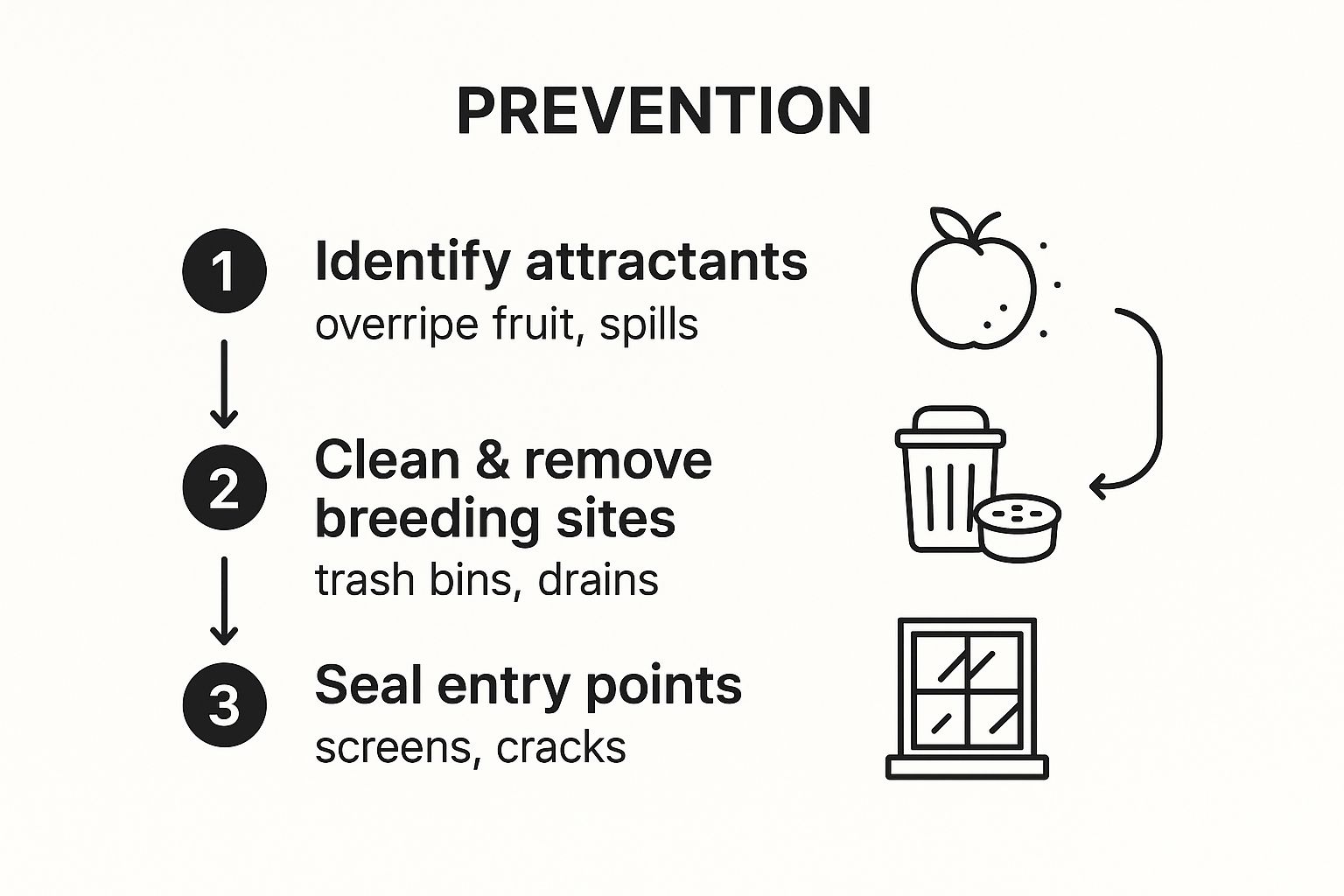
If you remove what’s attracting them, your DIY traps will work much faster.
Assembling a Better Fruit Fly Trap
Ready to build your trap? Grab a small jar or bowl and pour in an inch of apple cider vinegar. Add two to three drops of dish soap and give it a gentle swirl. That's it. Don't cover it—leave it open for easy access.
Expert Tip: Warm the vinegar in the microwave for 15 seconds before setting it out. Heat amplifies the scent, turning your trap into an irresistible beacon that draws flies from across the room.
Place traps anywhere you see fruit flies, like near the sink, the fruit bowl, or the garbage can.
Experiment with different baits. A splash of red wine or a piece of overripe banana in the vinegar can make the trap even more alluring. These non-toxic methods are a huge plus when you're figuring out how to keep flies away from food. Setting up a few traps will rapidly reduce the adult population and help you get the problem under control.
A Modern Approach to Continuous Fly Control
While traps and cleaning are essential, they require constant effort. For a "set-it-and-forget-it" defense, use technology to create a permanent no-fly zone. This approach uses the simple but powerful force of air, with no chemicals or baits required.
The concept is simple. Fruit flies are weak flyers. Their small size makes them vulnerable to air currents, and even a gentle breeze makes it nearly impossible for them to land, feed, or lay eggs on your food.
How Air Circulation Creates a Barrier
Devices like the Modern Lyfe fly fans generate a quiet, steady airflow that acts as an invisible shield over your countertops and tables.
It's less about repelling them and more about making your space physically impossible for them to navigate. By keeping the air moving, you prevent fruit flies from ever gaining a foothold.
This solution works silently in the background, offering 24/7 protection without any effort on your part. To see how it works, check out this guide on the Modern Lyfe fly fan and its benefits.
Ideal Placement for Maximum Impact
Placement is key to getting the most out of a fly fan. Think like a fruit fly and set up your defense in their favorite spots.
Here are the best locations:
- Directly Over the Fruit Bowl: This is ground zero. A fan placed here makes your fruit untouchable.
- Near the Kitchen Sink: A fan nearby will deter them from exploring the moist drain area for breeding.
- On the Dining Table: A fly fan is a game-changer during meals, especially outdoors. It protects your food so you can eat in peace.
It’s a safe, silent, and sleek way to complete your pest control strategy.
Advanced Tactics for Stubborn Infestations
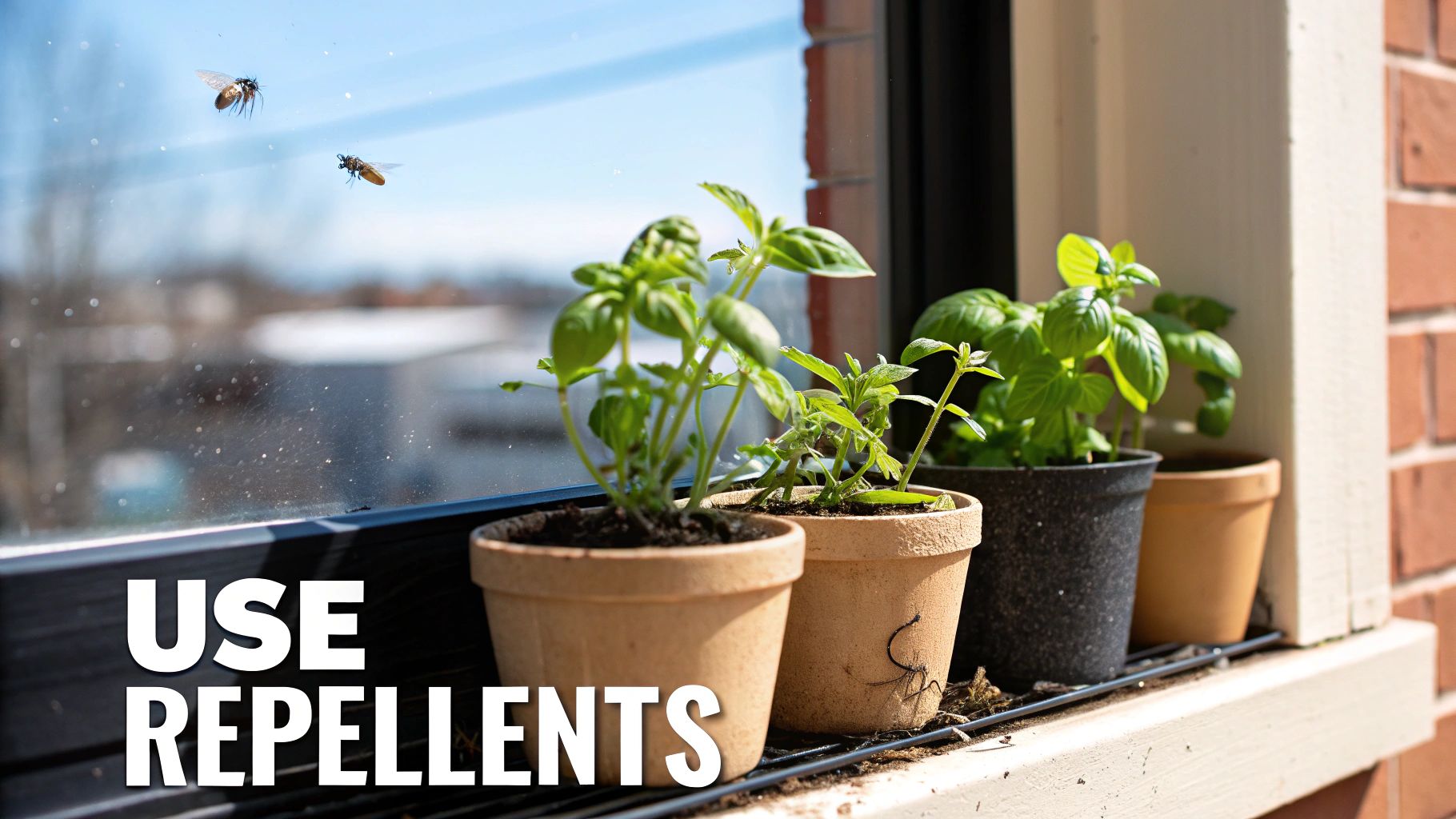
You've cleaned, set traps, and still have fruit flies. It’s frustrating. When an infestation won't quit, it's almost always due to a hidden breeding ground you've missed.
The adult flies are just the visible part of the problem. The real battle is at their source. It's time for a "search and destroy" mission into the forgotten corners of your home where organic gunk builds up.
The Hidden Breeding Ground Checklist
If you’ve handled the usual suspects, it’s time to play detective. A persistent infestation means a food source is hiding in plain sight. Investigate these less-obvious hotspots:
- Refrigerator Drip Pan: Pull your fridge out and inspect the pan underneath. It catches condensation but also collects grime, creating a soupy paradise for fruit fly larvae.
- Mops and Sponges: A sour-smelling sponge is a jackpot for fruit flies. A damp mop or wet sponge is an open invitation. Ensure they dry completely between uses.
- Forgotten Produce: A single potato or onion rolled to the back of a dark pantry can break down and sustain an entire infestation.
You're not just fighting a few pests; you’re up against a resilient species. There are over 1,500 species of fruit flies, many causing major economic damage to crops.
This shows how adaptable they are. One forgotten apple core can start a cycle that feels impossible to stop. You can read more research on fruit fly species and their economic effects.
At this stage, consistency is everything. Once you find and eliminate the hidden source, the adult flies have nowhere left to lay eggs. Keep using your traps and fly fans during this final push to break the cycle for good.
Common Questions About Repelling Fruit Flies
Even with a solid plan, you might still have questions. Let's tackle the most common ones to help you finalize your strategy and get rid of these pests.
Where Did They Even Come From?
It feels like they appear out of thin air, but the truth is sneakier. Their eggs are often already on the produce you bring home. With a life cycle of about a week from egg to adult, a few unseen hitchhikers can become a swarm overnight.
Are They Actually a Problem?
Are fruit flies really harmful? While they don't bite, they are more than a nuisance. They travel from unsanitary surfaces, like your trash can, directly to your food. Getting rid of them is a matter of both peace of mind and basic kitchen hygiene.
What’s the Fastest Way to Get Rid of Fruit Flies?
For immediate results, you need a two-pronged attack.
First, cut off their food supply. Toss any overripe produce and thoroughly clean your drains. Simultaneously, set up several DIY apple cider vinegar traps around your kitchen to catch the existing adult flies. This combination stops the breeding cycle while rapidly reducing the current population.
These tiny pests cause big problems beyond our homes. On farms, fruit flies can lead to production losses of 10% to 30% in certain crops, translating to billions in economic damage annually. You can find more details on these agricultural impacts on annualreviews.org.
The real secret is consistency. If you let your routine slip for even a day, you give a new generation of flies the foothold they need. Keep up with cleaning and trapping for at least a full week to ensure you've completely broken their life cycle.
Sticking with it is the only surefire way to reclaim your kitchen.
For a modern, continuous solution that keeps your space protected, trust MODERN LYFE. Our elegant fly fans create an effective, chemical-free barrier, ensuring your food and gatherings remain completely undisturbed. Explore our collection at https://modernlyfe.com.

